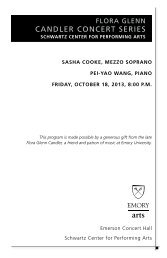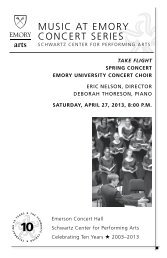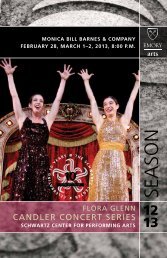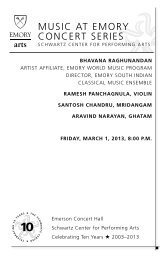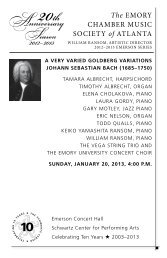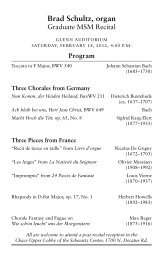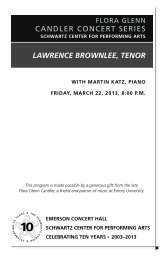This page intentionally left blank to represent front cover of program.
This page intentionally left blank to represent front cover of program.
This page intentionally left blank to represent front cover of program.
Create successful ePaper yourself
Turn your PDF publications into a flip-book with our unique Google optimized e-Paper software.
<strong>This</strong> <strong>page</strong> <strong>intentionally</strong> <strong>left</strong> <strong>blank</strong><br />
<strong>to</strong> <strong>represent</strong> <strong>front</strong> <strong>cover</strong> <strong>of</strong> <strong>program</strong>.
Emory University Department <strong>of</strong> Music<br />
presents<br />
Waiting on the Lord<br />
A Master <strong>of</strong> Music Recital<br />
in Partial Fulfillment for the Degree Master <strong>of</strong> Music<br />
Emory University Mastersingers<br />
Russell Hallman, conduc<strong>to</strong>r<br />
with<br />
Rob Lynch, piano<br />
EMERson concERt HALL<br />
scHwARtz cEntER FoR PERFoRMing ARts<br />
sUnDAy, FEbRUARy 19, 2012, 5:00 P.M.<br />
Program<br />
Aus der Tiefen rufe ich, Herr, zu dir, bwV 131 Johann sebastian bach<br />
(1685–1750)<br />
soloists: Kristen wiram, soprano; natalie weiss, al<strong>to</strong>;<br />
tyrone webb, tenor; Joel thompson, bass<br />
orchestra<br />
Songs <strong>of</strong> Anguish<br />
Sehnsucht Johannes brahms<br />
(1833–1897)<br />
I Love My Love gustav Holst<br />
(1874–1934)<br />
Great God <strong>of</strong> Love Robert Lucas Pearsall<br />
(1795–1856)<br />
Songs <strong>of</strong> Praise<br />
Rytmus ivan Hrušovský<br />
(1927–2001)<br />
I Believe in the Sun Jonathan Adams<br />
(b. 1962)
Songs <strong>of</strong> Prayer<br />
Rest Ralph Vaughan williams<br />
(1872–1958)<br />
Opferlied, op. 121b Ludwig van beethoven<br />
(1770–1827)<br />
Madhura Hallman, soprano<br />
“Lux Aeterna” from Nimrod Variations Edward Elgar<br />
(1857–1934)<br />
(arr. John cameron)<br />
Songs <strong>of</strong> Hope<br />
At the Round Earth’s Imagined Corners williametta spencer<br />
(b. 1932)<br />
“in Remembrance” from Requiem Eleanor Daley<br />
(b. 1955)<br />
City Called Heaven arr. Josephine Poelinitz<br />
chonise thomas, soprano<br />
Program Notes<br />
M usic possesses a power <strong>of</strong> expression that runs deeper than the<br />
word alone. <strong>to</strong>night we celebrate that power, particularly the<br />
ability <strong>of</strong> choral music <strong>to</strong> capture and communicate the meanings <strong>of</strong> the<br />
soul. the psalmist writes, “i wait for the Lord, my soul doth wait . . . ”<br />
(Psalm 130:5). what does it mean <strong>to</strong> wait on the Lord? in a frantic culture<br />
<strong>of</strong> light-speed business and information at our fingertips, it is a bizarre<br />
and counterintuitive instruction. <strong>to</strong>night we slow down and listen <strong>to</strong> the<br />
glorious melodies that will provide deeper insight in<strong>to</strong> this mystery. this<br />
recital is a secular <strong>program</strong> exploring the sacred theme <strong>of</strong> waiting on the<br />
Lord through the majesty <strong>of</strong> choral music.<br />
Aus der Tiefen rufe ich, Herr, zu dir is one <strong>of</strong> Johann sebastian bach’s<br />
earliest cantatas, composed soon after arriving in Mühlhausen in June<br />
1707. Just prior <strong>to</strong> bach’s appointment, a fire destroyed a large part <strong>of</strong> the<br />
city. this work was likely written for st. Mary’s church <strong>to</strong> commemorate<br />
the tragedy. the text was chosen by g. c. Eilmar, who commissioned<br />
the work and served as pas<strong>to</strong>r <strong>of</strong> the church. bach combines the texts <strong>of</strong><br />
Martin Luther’s translation <strong>of</strong> Psalm 130 with the chorale Herr Jesu Christ,<br />
du höchstes Gut from german hymn writer bartholomäus Ringwaldt.<br />
the Adagio section begins with a call-and-response duet between the<br />
violin and oboe followed by laments from the chorus. the vocal laments<br />
morph in<strong>to</strong> pleas starting at the Vivace section with cries <strong>of</strong> “Lord, hear<br />
my voice.” Already at age twenty-two, bach demonstrates his skill at
harmony and contrapuntal writing. the following Andante movement<br />
for bass and soprano soloists starts with the bass, whose short phrases<br />
become progressively longer and increasingly melismatic in declaring fear<br />
<strong>of</strong> the Lord’s judgement. simultaneously, the soprano sings contrasting,<br />
sustained lines that cry out for mercy and redemption. this recital draws<br />
its title from the third movement and center section, which begins with<br />
choral, homophonic cries <strong>of</strong> “i wait for the Lord” (Ich harre des Herrn).<br />
this is followed by a tender, slow fugue on the text “my soul waits, and in<br />
his word do i hope.” throughout the fugue, the oboe and violin enjoy a call<br />
and response duet while the voices support with long, lyrical descending<br />
phrases. the movement ends with a hopeful g major chord which<br />
contrasts with the initial g minor from the first and second movements.<br />
the fourth movement follows the same pattern <strong>of</strong> the second—the tenor<br />
sings the more demanding vocal line while the al<strong>to</strong> enunciates the words <strong>of</strong><br />
redemption in lega<strong>to</strong> phrases above. bach <strong>of</strong>ten has the voices cross in this<br />
section <strong>to</strong> signify how these messages are intertwined—that waiting on the<br />
Lord is a process <strong>of</strong> redemption. the homophonic final section declares<br />
god’s grace <strong>to</strong>wards israel, but then ushers in a sprightly fugue that states<br />
and restates the coming <strong>of</strong> israel’s redemption from Him. this last section<br />
is the more demanding and melismatic <strong>of</strong> the two fugues, but like the third<br />
movement, ends on the hopeful g major chord.<br />
Songs <strong>of</strong> Anguish<br />
waiting is <strong>of</strong>ten considered painful. it can be merely an irritation or a<br />
soul-wrenching ache. Many composers created their best-known works<br />
while in a state <strong>of</strong> depression or hurt. Music <strong>of</strong>ten reveals the veiled beauty<br />
within such trying circumstances.<br />
Johannes brahms, considered one <strong>of</strong> the greatest choral composers, sets<br />
Franz Kugler’s poem, Sehnsucht or “longing,” during the latter part <strong>of</strong> his<br />
compositional period. the accompaniment sets the mood by expressing<br />
emotional turmoil in the triplets against quadruplets and depicts longing<br />
“running like water” via ascending and descending arpeggios. the vocal<br />
lines sigh with lyricism, burdened with pain in their chromaticism and<br />
delayed harmonic resolutions.<br />
gustav Holst’s I Love My Love is an a cappella arrangement <strong>of</strong> a cornish<br />
folk song that hails from cornwall, from which come the legends <strong>of</strong> King<br />
Arthur and tristan and isolde. I Love My Love tells <strong>of</strong> a woman placed<br />
in an insane asylum where she waits for her lover who eventually returns<br />
from sea <strong>to</strong> rescue her. throughout the song’s six verses, Holst weaves the<br />
melody through different voice parts <strong>to</strong> illustrate different characters. the<br />
remaining voice parts accompany the melody via siren-like calls from the<br />
women and sustained chords in the lower voices.<br />
4
Robert Lucas Pearsall is best known for helping revive Renaissance<br />
music in nineteenth-century England. combining his german training<br />
with his study <strong>of</strong> sixteenth-century madrigals, Pearsall fully emulates the<br />
Elizabethan style while pushing beyond the harmonic conventions from<br />
the past. A misleading title, Great God <strong>of</strong> Love is a plea <strong>to</strong> cupid <strong>to</strong> “bend<br />
his bow” at Amarillis that she might feel the same ardent fervor <strong>of</strong> her<br />
lover whose heart wastes away waiting from unrequited love. Pearsall’s<br />
eight-part setting provides a rich, polyphonic texture through which he<br />
threads several harmonic suspensions <strong>to</strong> paint the lover’s pain.<br />
Songs <strong>of</strong> Praise<br />
Due <strong>of</strong>ten <strong>to</strong> anguish, praise is difficult while waiting, yet the psalmist<br />
certainly <strong>of</strong>fers his share. However, there are seasons <strong>of</strong> joyful anticipation—<br />
the season <strong>of</strong> Advent or the engagement period before a wedding. whether<br />
a resounding “gloria” or a coronation anthem, choral music is unmatched<br />
in lavishing praise and is <strong>of</strong>ten used by composers for that end.<br />
Rytmus, translated “rhythm,” is the last <strong>of</strong> three choral etudes by<br />
slovakian composer, ivan Hrušovský. this piece provides a choral<br />
obstacle course both rhythmically and harmonically. the text, written by<br />
the composer, proclaims praise <strong>to</strong> Eve—“the queen <strong>of</strong> all nobleness”—and<br />
facilitates the rapid-fire outbursts from the chorus. the meter changes,<br />
sudden dynamic shifts, and final choral shouts all contribute <strong>to</strong> the<br />
rapturous energy <strong>of</strong> the work.<br />
Dedicated <strong>to</strong> the victims <strong>of</strong> hurricane Katrina, Jonathan Adams’s<br />
I Believe in the Sun addresses the darker side <strong>of</strong> praise: when god is<br />
missing. the anonymous text was found scratched in<strong>to</strong> a basement wall by<br />
someone hiding from the gestapo. it consists <strong>of</strong> three iterations: i believe<br />
in the sun; i believe in love; i believe in god. Adams depicts the simplicity<br />
<strong>of</strong> these statements with stepwise melodies and close, clustered harmonies.<br />
Songs <strong>of</strong> Prayer<br />
Prayer sustains communion with the Divine. without that fellowship,<br />
waiting loses its purpose and becomes meaningless. Music, <strong>of</strong>ten a form <strong>of</strong><br />
prayer, communicates longings and feelings <strong>to</strong>o deep for words.<br />
Ralph Vaughan williams composed Rest in 1902 with regard <strong>to</strong> the<br />
popularity <strong>of</strong> part songs and madrigals. the text, a poem by christina<br />
Rossetti, is a prayer for the Earth <strong>to</strong> closely <strong>cover</strong> a deceased woman<br />
until the morning <strong>of</strong> Eternity where she will sleep no longer. williams sets<br />
the poem for a cappella choir and in a five-part homophonic texture <strong>to</strong><br />
enrich the harmony and <strong>to</strong> ease comprehension. He ends the work with a<br />
triumphant E major chord as she wakes <strong>to</strong> Eternity.<br />
bridging the classical and the Romantic musical periods, Ludwig van<br />
beethoven remains one <strong>of</strong> the greatest composers <strong>of</strong> all time. one <strong>of</strong> his<br />
5
favorite texts was Friedrich von Matthisson’s Opferlied, which beethoven<br />
set four times during his life. this version, written in 1824, is the last <strong>of</strong><br />
the settings. the text involves a young man <strong>of</strong>fering sacrifice <strong>to</strong> zeus and<br />
asking for beauty and goodness now and for his aging years. scholars have<br />
questioned beethoven’s obsession with this text, and “it seems always <strong>to</strong><br />
have presented itself <strong>to</strong> him as a prayer.” beethoven elaborates on the<br />
lovely, lyrical melody in the second verse with swift dynamic changes in<br />
the accompaniment.<br />
it was not until sir Edward Elgar reached his forties that he achieved<br />
great fame as a musician in England. He was knighted in 1904 and received<br />
other such honors during the next three decades. Lux Aeterna, arranged<br />
by John cameron, is derived from one <strong>of</strong> Elgar’s most celebrated works,<br />
Nimrod from his Enigma Variations. the text is from the communion<br />
portion <strong>of</strong> the Requiem Mass praying for eternal light <strong>to</strong> shine on the<br />
deceased and that they may find eternal rest in the Lord. cameron’s eightpart<br />
setting captures the rich orchestration <strong>of</strong> Elgar’s original composition.<br />
Songs <strong>of</strong> Hope<br />
At the heart <strong>of</strong> waiting is hope. whether it is a paycheck, promotion,<br />
vic<strong>to</strong>ry, adventure, or rest, hope is a great motiva<strong>to</strong>r. in terms <strong>of</strong> waiting<br />
on the Lord, hope refers <strong>to</strong> a journey beyond our three score years and ten<br />
and a coming world that agrees with our sense <strong>of</strong> what should be.<br />
williametta spencer’s At the Round Earth’s Imagined Corners won<br />
the 1968 composition competition <strong>of</strong> the southern california Vocal<br />
Association. A setting <strong>of</strong> John Donne’s Holy Sonnet VII, the text refers<br />
<strong>to</strong> the last trumpet <strong>of</strong> Revelation and the resurrection <strong>of</strong> souls. However,<br />
Donne realized that god should let those souls rest until he works out his<br />
own sinful situation. thus, he prays for delaying god’s Judgement Day<br />
in hope that his soul by then might be spared. spencer paints these shifts<br />
<strong>of</strong> thought through alternating meters and abrupt dynamic changes that<br />
capture both the angelic call-<strong>to</strong>-arms and Donne’s humble supplication.<br />
one <strong>of</strong> Eleanor Daley’s most well-known works is her Requiem from<br />
which In Remembrance is drawn. the anonymous poem Do Not Stand<br />
at My Grave and Weep describes the continuation <strong>of</strong> life in<strong>to</strong> all things.<br />
it provides hope that death claims no finality but is only a transfiguration<br />
from one state <strong>to</strong> the next. Daley captures this state through the harmonic<br />
language—primarily modulating between major sonorities.<br />
the <strong>program</strong> closes with Josephine Poelinitz’s arrangement <strong>of</strong> City<br />
Called Heaven. Here, Poelinitz salutes the American gospel heritage evident<br />
in the vocal spacing and piano accompaniment. while the soloist laments<br />
about life’s troubles, the chorus and piano accompany with short, sighing<br />
pulses. these aspects in the context <strong>of</strong> the F minor sonority create a weary<br />
hopelessness overcome only by the hope <strong>to</strong> “make heaven my home.”<br />
6
Russell Hallman<br />
Russell Hallman is a master <strong>of</strong> music candidate studying choral<br />
conducting with Eric nelson and voice with bradley Howard.<br />
in 2009, he graduated from georgia state University with a degree in<br />
vocal performance from the studio <strong>of</strong> sharon stephenson. He has lived in<br />
Atlanta since 2001 and he has performed with the esteemed Atlanta opera<br />
chorus; georgia tech’s sympathetic Vibrations, glee club, and chamber<br />
choir; the georgia state University chorus; the Atlanta sacred chorale;<br />
and the Like the Dickens carolers. since its formation in 2009, Hallman<br />
has served as associate music direc<strong>to</strong>r <strong>of</strong> the children’s Healthcare <strong>of</strong><br />
Atlanta volunteer choir. He has sung with many churches in the Atlanta<br />
area and currently serves at Morningside baptist church.<br />
Emory University Mastersingers<br />
Soprano al<strong>to</strong> tenor BaSS<br />
Meg granum Hannah Rose blakely Jonathan Easter Roy Atwood<br />
zoë Pollock Janice Kuo Jake Light Andrew bolden<br />
Meredith sharps Laurie Ann taylor tyrone webb Rob Lynch<br />
chonise thomas Hannah tee<strong>to</strong>r c. J. shepard brad schultz<br />
Kristen wiram natalie weiss Joel thompson<br />
Orchestra<br />
Rebecca collins, oboe; Domenic salerni, violin; yinzi Kong, viola;<br />
Margaret granum, viola; guang wang, cello; Rob Lynch, harpsichord<br />
Arts at Emory Box Office/Audience Information<br />
404.727.5050 • arts.emory.edu<br />
the department <strong>of</strong> music gratefully acknowledges the generous gift <strong>of</strong> musical instruments<br />
provided by the Dr. b. woodfin cobbs Jr. Music Endowment.<br />
the cough drops in the lobby are courtesy <strong>of</strong> Margery and Robert McKay.<br />
in consideration for other members <strong>of</strong> the audience, please turn <strong>of</strong>f all <strong>page</strong>rs and phones.<br />
Pho<strong>to</strong>graphs and recordings may not be made during a performance without advance permission.<br />
Ushers are members <strong>of</strong> Music at Emory Volunteers; Alpha Phi omega, a national service and<br />
social fraternity; and tri-M Music Honor society at Lakeside High school. call 404.727.6640 for<br />
information about ushering.<br />
<strong>cover</strong> pho<strong>to</strong>graphy credits: (a) Vega String Quartet, pho<strong>to</strong> by<br />
Ann borden; (B) Sachal Vasandani, jazz vocalist, pho<strong>to</strong> courtesy<br />
E<br />
A B<br />
<strong>of</strong> Unlimited Myles inc.; (C) Dane Philipsen, oboe, pho<strong>to</strong> by<br />
Mike Muszynski; (D) Barenaked Voices 2011 A Cappella Concert,<br />
C pho<strong>to</strong> by <strong>to</strong>m brodnax; (E) Matt Haimovitz, cello, pho<strong>to</strong> by<br />
steph MacKinnon; (F) Jazz on the Green, pho<strong>to</strong> by gary Motley<br />
F<br />
D Frequently updated event and <strong>program</strong> information available<br />
online at arts.emory.edu.<br />
facebook.com/emoryarts<br />
twitter.com/emoryarts<br />
Music at emory<br />
7



